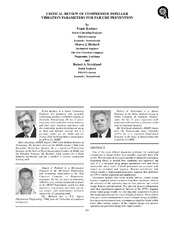| dc.contributor.other | Turbomachinery Symposium (29th : 2000) | |
| dc.creator | Kushner, Frank | |
| dc.creator | Richard, Shawn J. | |
| dc.creator | Strickland, Robert A. | |
| dc.date.accessioned | 2017-10-05T14:00:25Z | |
| dc.date.available | 2017-10-05T14:00:25Z | |
| dc.date.issued | 2000 | |
| dc.identifier.uri | https://hdl.handle.net/1969.1/163360 | |
| dc.description | Lecture | en |
| dc.description | Pg. 103-102 | en |
| dc.description.abstract | One of the most difficult diagnostic problems for centrifugal compressors is fatigue failure of an impeller, especially those with covers. The structure of a covered impeller is inherently resistant to alternating forces at normal flow conditions and operation, but only if it is designed using proper parameters over and above steady-state stress limits. Critical parameters are reviewed with respect to excitation and response. Besides well-known disk critical speeds, a fundamental parametric equation first published in 1979 is further explained and emphasized. Occasional failures that occur usually involve certain design features coupled to added excitation from flow variations, either at the extremes of the operating map or form process and control design features and deviations. Test data for process refrigeration units that experienced numerous failures in the 1970’s required actual strain gauge results via slip ring data acquisition to prove that liquid ingestion was the cause of high excitation. These critical data gave much confirmation to assist in future design reliability. In a more recent unusual case, a compressor impeller failed within hours after startup; aspects of the original design and process operation are presented along with improvements. Some cases require special internal instrumentation to solve recurring failures. Documentation of failures including some with liquid ingestion is discussed, along with suggestions for review to mitigate potential failures of repaired unites as well as new designs. Also discussed is confirming evidence from other references where applicable. Design improvements, both for older and more efficient impellers, are shown to reduced risk, especially for those with vaned diffusers. | en |
| dc.format.medium | Electronic | en |
| dc.format.mimetype | application/pdf | |
| dc.language.iso | en | |
| dc.publisher | Texas A&M University. Turbomachinery Laboratories | |
| dc.relation.ispartof | Proceedings of the 29th Turbomachinery Symposium | en |
| dc.subject.lcsh | Turbomachines | en |
| dc.title | Critical Review Of Compressor Impeller Vibration Parameters For Failure Prevention. | en |
| dc.type.genre | Presentation | en |
| dc.type.material | Text | en |
| dc.identifier.doi | https://doi.org/10.21423/R1F959 | |


